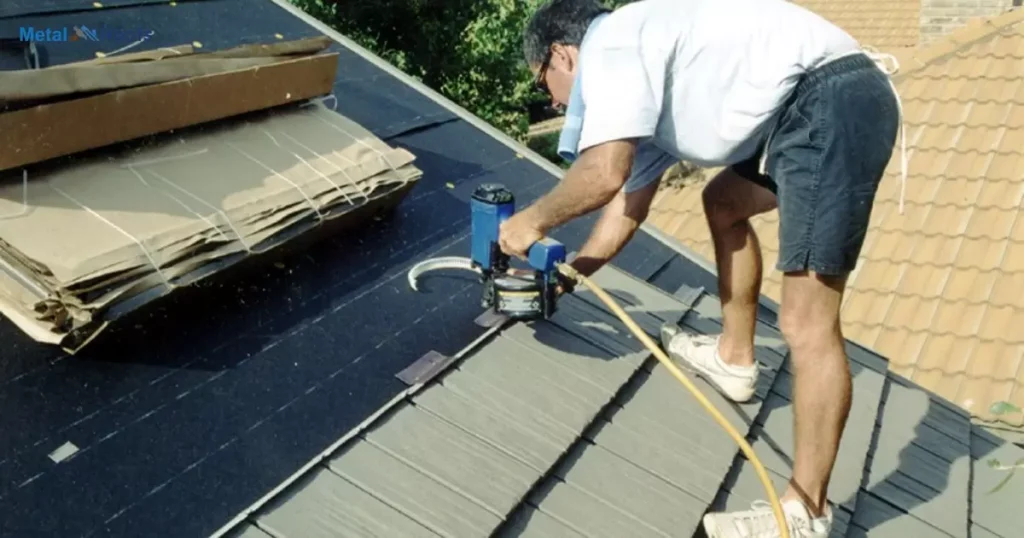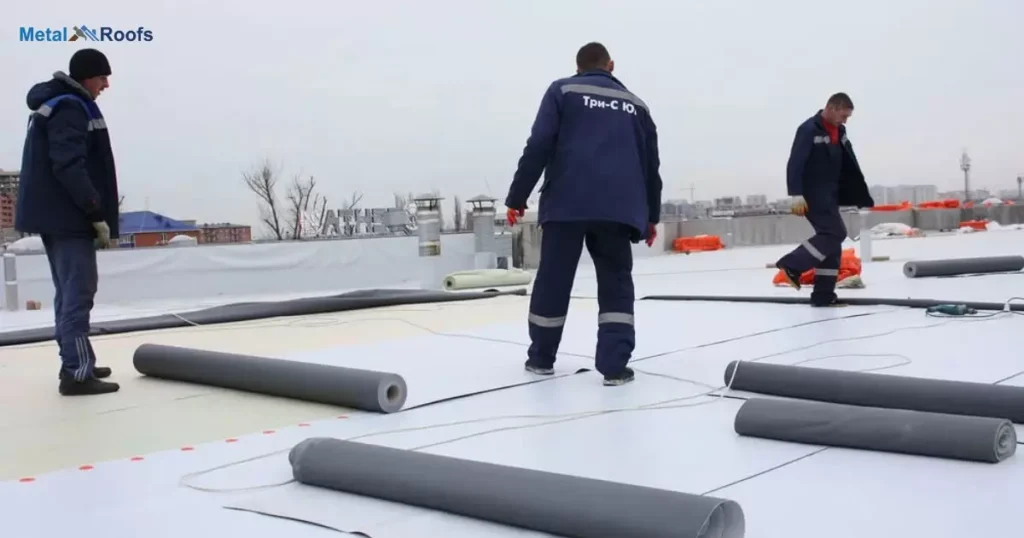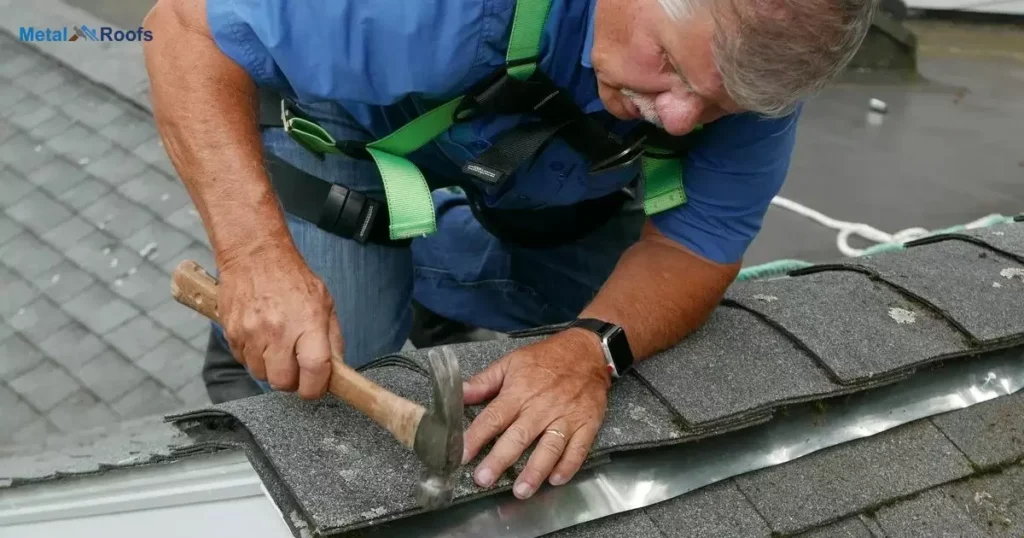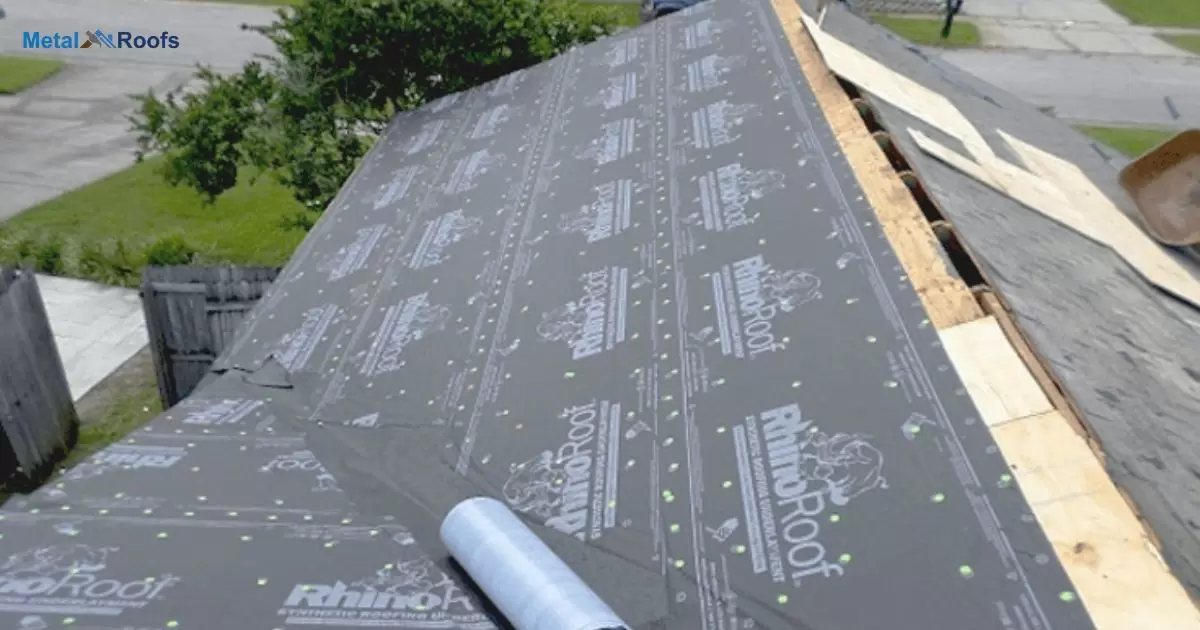Tar paper under a metal roof stops leaks and moisture. It insulates your home better. It cuts down on rain noise. Tar paper protects your roof deck from damage. It helps your metal roof last longer.
Your metal roof needs a secret hero. It’s tar paper. This layer does more than you think. It fights leaks and moisture. It keeps your home cozy. So, do i need tar paper under metal roof? Yes. It’s your roof’s best friend.
install heat cable on metal roof can further enhance its durability and functionality. Tar paper isn’t just an extra step. It’s a key player in your roof’s defense team. This layer works hard under your metal roof, blocking water and stopping rot, while also keeping your energy bills down.
Key Takeaways
- Prevents condensation damage.
- Adds a layer of leak protection.
- Provides fire resistance.
- Dampens rain and hail noise.
- Often required by local codes.
- Synthetic underlayments can be more durable.
Moisture Barrier Under Metal Roof
A moisture barrier under a metal roof is crucial. It stops condensation from damaging the roof deck. This layer keeps water out, protecting the structure. Moisture can cause rot and mold. A barrier helps maintain a healthy home.
Many building codes require a moisture barrier. It provides extra protection against leaks. Even in dry climates, it offers other benefits. Choose modern synthetic materials for better durability. Always consult a roofing expert for the best advice. This ensures your roof stays strong and safe.
Underlayment Metal Roof
| Underlayment Type | Description |
| Tar Paper | Traditional, provides moisture barrier |
| Synthetic Underlayment | Modern, durable, offers moisture protection |
Underlayment for a metal roof provides essential protection. It helps prevent moisture from damaging the roof deck. It stops leaks, adding an extra layer of security. Underlayment also reduces noise from rain and enhances fire resistance. Many building codes require it, making it a standard practice in roofing.
You have options for underlayment materials. Tar paper and modern synthetic materials both work effectively. The best choice can depend on your climate. In dry areas, the need for moisture protection is less critical. Always consult a roofing expert for advice. Follow local building codes to ensure proper installation.
Install Metal Roof

Installing a metal roof? Start with proper preparation. Clean the roof surface thoroughly. Remove any debris or old roofing material. Ensure the roof deck is smooth and free of protrusions. Next, lay down the underlayment. Tar paper works well for moisture protection.
Follow local building codes. Then, it’s time for the metal panels. Secure them tightly to the roof deck. Finally, seal the seams and edges to prevent leaks. Take your time and work carefully for a durable and weatherproof metal roof.
Underlay For Metal Roofing
When installing a metal roof, consider using an underlayment like tar paper. It acts as a moisture barrier, stopping condensation from causing damage. It adds an extra layer of protection against leaks, safeguarding your home.
Tar paper also offers fire resistance and reduces noise from rain or hail. Many local codes require it, ensuring compliance and safety. Synthetic underlayments can be more durable alternatives. Consult a professional to determine the best option for your metal roofing project.
Underlayment For Steel Roof
Considering underlayment for a steel roof? It’s crucial. Underlayment acts as a barrier against moisture, protecting the roof deck. This extra layer shields against leaks, safeguarding the structure beneath. Most local codes mandate underlayment, often tar paper.
Yet, alternatives like synthetic materials are gaining popularity for their durability. Climate matters too in dry areas, underlayment’s importance might lessen, but it still offers benefits. Consult a professional for the best choice, ensuring compliance with local regulations.
High Temperature Underlayment For Metal Roof

If you’re considering a metal roof, think about the underlayment. High temperatures demand a durable solution. Underlayment acts as a barrier, protecting your roof from heat and moisture. It’s crucial for maintaining the roof’s integrity over time.
High-temperature underlayment provides extra protection, ensuring your roof lasts longer. Without it, your roof might suffer from heat damage. So, choose wisely and invest in quality underlayment for your metal roof.
Types Of Tar Paper
Tar paper, also known as roofing felt or felt paper, comes in several types, each with its own specific application and characteristics:
Asphalt-Saturated Felt: This is the most common type of tar paper. It is made by saturating a felt-like material with asphalt to create a water-resistant barrier. It’s typically used as an underlayment beneath roofing materials like shingles or tiles.
Synthetic Roofing Underlayment: While not technically tar paper, synthetic underlayment serves a similar purpose. It’s made from polyethylene or polypropylene and offers superior tear resistance and durability compared to traditional felt paper.
Rubberized Asphalt Underlayment: This type of underlayment combines asphalt with rubber polymers, providing enhanced waterproofing properties and flexibility. It’s often used in areas prone to extreme weather conditions.
Self-Adhering Membranes: These membranes have an adhesive backing that allows for easy installation without the need for nails or staples. They provide excellent waterproofing and are commonly used in low-slope roofing applications.
Ice and Water Shield: This is a specialized type of underlayment designed to protect against ice dams and water infiltration in vulnerable areas of the roof, such as eaves and valleys. It typically has a self-sealing adhesive backing and is highly resistant to water penetration.
Each type of tar paper has its own advantages and is chosen based on factors such as climate, roof slope, and specific roofing requirements.
Alternatives To Traditional Tar Paper
When considering alternatives to traditional tar paper for roofing, modern synthetic underlayments emerge as durable options. These materials offer enhanced protection against moisture and leaks while complying with building codes. Unlike tar paper, they resist tearing and wrinkling during installation.
Synthetic Underlayment
Under the heading alternatives to traditional tar paper, synthetic underlayment stands out as a durable option. These modern materials offer enhanced moisture protection and comply with building codes.
Self-Adhering Membrane
Self-adhering membranes offer a modern solution for roofing underlayment. They ensure easy installation without the need for additional adhesives. These membranes provide superior protection against moisture and leaks, surpassing traditional tar paper in durability and efficiency.
Felt Paper
Under the category of alternatives to traditional tar paper, felt paper emerges as a familiar choice. This material, often used in roofing, offers a basic level of moisture protection and can serve as a temporary solution. While less durable than modern synthetic underlayments, felt paper remains a cost-effective option for certain roofing projects.
Why Use Tar Paper Under Metal Roof?

Using tar paper under a metal roof is essential. It shields against moisture, safeguarding the roof deck from harm. It adds an extra layer of defense against leaks, protecting the underlying structure. Tar paper also offers fire resistance, crucial for safety in fire-prone areas.
It helps dampen the noise from rain and hail, making indoor spaces quieter. Following local building codes, many jurisdictions require its use. While alternatives like synthetic underlayments exist, tar paper remains a widely accepted choice for its reliability.
Frequently Asked Questions
Do You Need Wood Strips Under Metal Roofing?
Modern synthetic underlayments can provide effective moisture protection under metal roofing without the need for wood strips.
Do You Need Insulation Under A Metal Roof?
Insulation under a metal roof improves energy efficiency and prevents moisture issues, serving as a beneficial alternative to traditional tar paper.
Is Tar Paper Necessary When Roofing?
Modern synthetic underlayments offer comparable moisture and leak protection, potentially rendering traditional tar paper unnecessary in roofing projects.
Conclusion
When deciding whether to use tar paper under a metal roof, it’s crucial to weigh the benefits against modern alternatives. While tar paper offers moisture and leak protection, synthetic underlayments provide similar advantages and comply with building codes.
These alternatives, resistant to tearing and easy to install, may make tar paper obsolete in roofing projects. Advancements in roofing technology continually improve the performance and reliability of alternative materials, further challenging the necessity of traditional tar paper.











